Do you long for a bit of nature in your life, but don’t have the time or space for a full-blown garden? Or maybe you’ve got a green thumb, but want to add some new ideas to your gardening repertoire? No matter what your situation, this English Garden Ideas Guide is for you! It will answer common questions about creating an English garden, offer tips and advice on how to make yours flourish, and give you ideas for adding unique touches that will make your garden truly special. So, read on – and get inspired to create your own little piece of paradise!
What is an English Garden?
An English Garden is a type of garden that originated in England during the 18th century. It is characterized by its use of lush, naturalistic planting, often with an abundant variety of flowers and foliage. The gardens are also known for their winding paths and hidden areas, as well as other features such as ponds, birdbaths, statuary, and benches. English Gardens also feature formal elements like topiary, hedges, and box borders. They can be both formal or informal in style depending on the taste of the gardener.
English Gardens are designed to create an atmosphere of relaxation and tranquillity. They often feature winding paths that lead you through different areas of the garden, giving you plenty of places to explore and enjoy. It’s not uncommon for English Gardens to contain benches or seating areas which give visitors a chance to sit and take in their surroundings. Ponds with water features can also enhance the tranquillity of the space, attracting birds and wildlife into the garden. People who design English Gardens often strive to achieve a balance between beauty, formality, and pleasure.
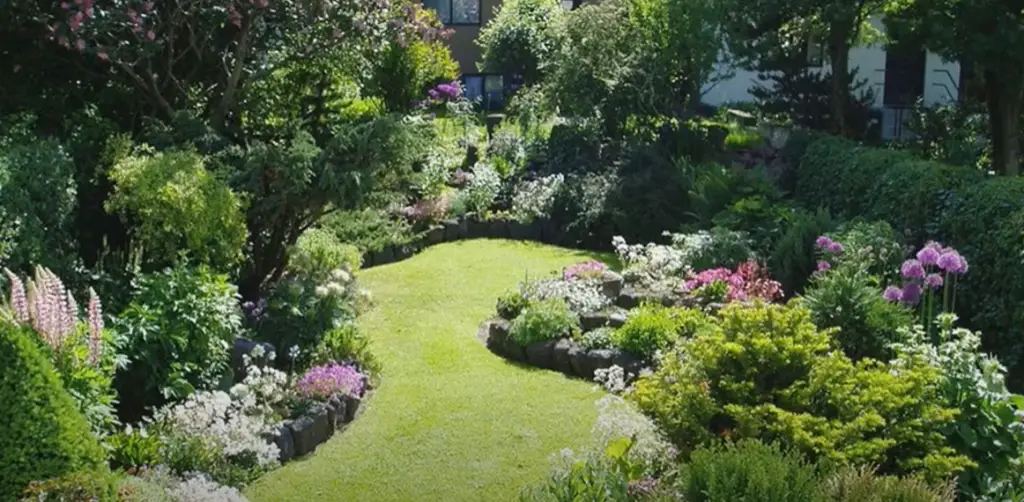
Overall, English Gardens are incredibly versatile; they can be tailored to any space, style, and budget. With the right plants, a little bit of creativity, and some hard work you can create your own beautiful English Garden [1]!
How do you lay out an English garden?
- Begin with basic design principles: English gardens are typically designed in a formal, symmetrical way that is pleasing to the eye. Carefully select shapes for garden beds and pathways, create focal points with large trees or ornamental plants, and use hedges to divide areas.
- Choose plants carefully: The individual plants you choose will have an enormous impact on the overall look of your garden, so choose them wisely and keep in mind what colors they’ll be blooming when. Planting a mixture of perennials and annuals will provide year-round interest, while climbers and shrubs give structure to your design.
- Consider hardscaping elements: Hardscaping elements like stone walls, paths, and fountains can help to create a distinctive look for your garden. Pavers, gravel, and mulch are some of the materials you might use in these elements.
- Add decorative features: Statues, birdbaths, and other ornaments can give your garden an extra special touch. Try to choose pieces that complement the overall design rather than detract from it.
- Maintain your garden: An English garden takes maintenance to keep it looking its best. Regularly prune plants, remove weeds and deadheads, fertilize when needed, and water during dry weather. This will ensure that your garden maintains its beauty year-round!
Classic English cottage garden plants
The traditional English cottage garden is known for its lush and abundant foliage, featuring a mix of perennials, annuals, shrubs, and trees. Classic cottage garden plants include roses, hollyhocks, lavender, peonies, foxgloves, daisies, lupins, and phlox.
These flowers are often combined with evergreens such as boxwood and yew to add structure and contrast to the planting scheme. Herbs like thyme and oregano can be planted alongside vegetables like beans or squash to create an edible landscape that is also pleasing to the eye. With careful planning, you can create a stunning display that will last throughout the summer months!
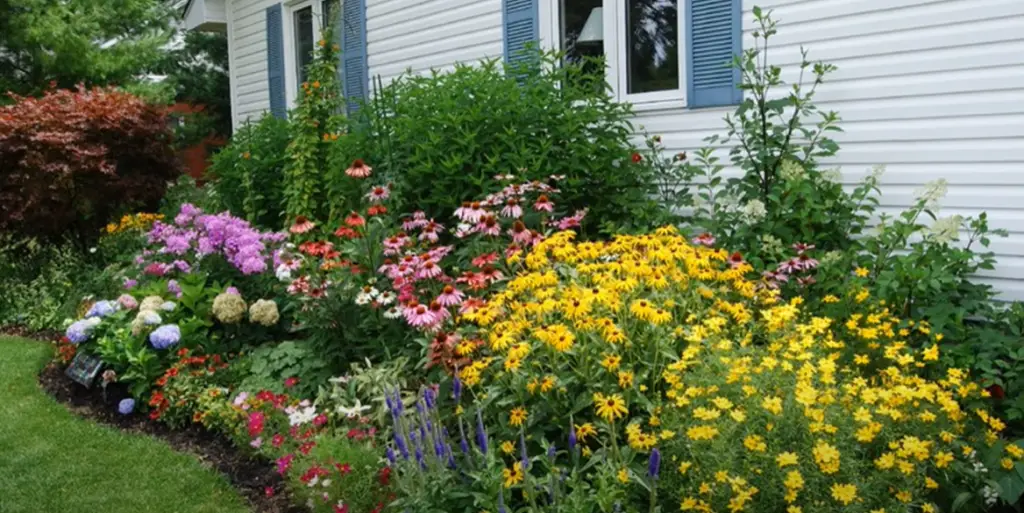
English garden ideas
Plant for extremes in weather
When it comes to creating an English garden, you have to consider the extremes in weather conditions. England may experience cold temperatures during the winter months and scorching hot days during summertime. Picking plants that can survive both hot and cold climates will ensure your English garden can grow year-round. Some of the more suitable options for extreme climates include perennials such as roses, lavender, clematis, and foxglove; evergreen bushes like boxwood or holly; grasses like fescue; shrubs like rhododendrons or azaleas; trees such as linden or oak; and annuals such as marigolds or petunias.
Create a focal point
When designing your English garden, you’ll want to create a central focal point. This could be anything from a birdbath or statue to an arbor or trellis. The focal point should draw attention and provide a stunning backdrop for the rest of your garden design. For instance, if you have an outdoor pond in your garden, you may want to add a bridge across it as the centerpiece of your landscape.
Include scented plants
One aspect that makes English gardens so special is the use of fragrant flowers and herbs. Include plants such as sweet peas, roses, lavender, jasmine, mint, thyme, and rosemary for their lovely aromas and colors. Placing them near pathways will allow visitors to enjoy the fragrance as they stroll through your garden.
Incorporate a seating area
An English garden isn’t complete without a cozy seating area where you can relax and admire the beauty of your outdoor space. You may want to add an outdoor bench or chair, or even a hammock for extra comfort. You could also build a small gazebo in your garden for added shade and shelter from the rain.
Paint pictures with English garden plants
The use of colorful plants is essential for creating an eye-catching English garden. Try planting a mix of both annuals and perennials to create a stunning display of color and texture. Consider adding bright hues like red, yellow, purple, or orange for maximum impact. Also, include other elements such as sculptures or water features in your garden design to give the space more depth and interest.
Get the flower borders right
Flower borders are essential in any English garden. They create a neat and well-defined edge to your outdoor space, while also providing an opportunity for you to get creative with your garden design. Choose smaller plants such as forget-me-nots or primroses for the edges of flower beds, then fill the middle with taller varieties such as foxgloves or delphiniums for an attractive contrast.
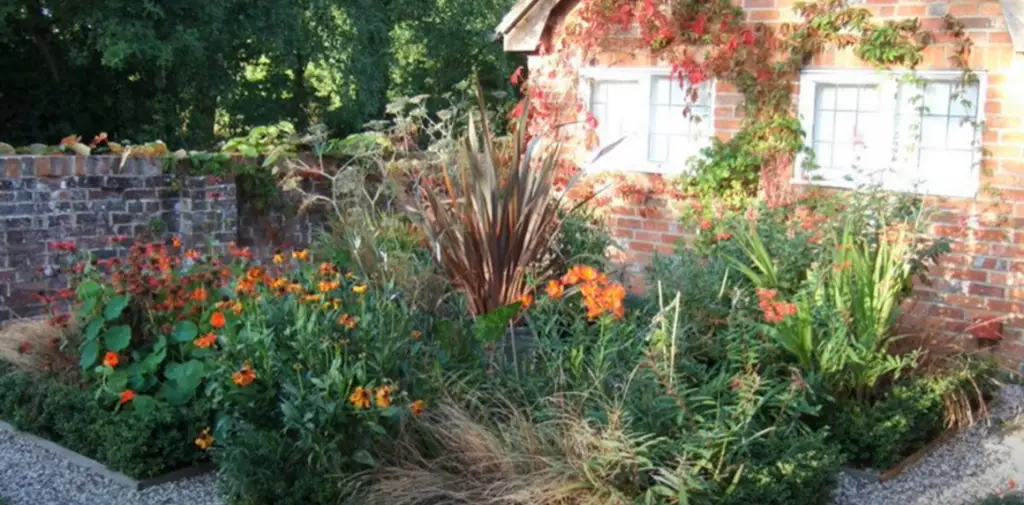
Introduce a meandering path
Installing a meandering path through your English garden will add a sense of mystery and create an inviting atmosphere for visitors. Consider using materials like stone, gravel, bark chippings, or brick to line your path. Plant low-lying shrubs along the edges of the pathway to ensure it’s well-defined and visually appealing.
Add texture with foliage
Foliage is key in any English garden design, as it helps to create texture and interest in your outdoor space. Incorporate plants with different leaf shapes or sizes such as Hostas, Fatsia Japonica, Euonymus japonicus ‘green rocket’ or Acer palmatum ‘Hayward’. These plants can also be used to create a beautiful backdrop for your flower beds.
Make use of topiary
Topiary is the art of trimming shrubs and trees into ornamental shapes and is commonly seen in British gardens. Consider adding evergreens such as boxes or yew to your garden design and then clipping them into topiary shapes like spirals, cones, pyramids, or animals. This will give your garden an extra dimension that’s sure to amaze visitors!
Add an architectural feature or folly
Adding an architectural feature or folly to your garden can help to create a unique atmosphere. Popular examples include a pergola, bridge, gazebo, or pagoda. You could also add an ornamental pond with a waterfall, or a secret garden tucked away in the corner of your outdoor space for added interest and intrigue.
Welcome a water feature
A water feature such as a fountain or pond is an excellent way to finish off your English garden. Not only will it create a tranquil atmosphere, but it will also attract wildlife and provide a beautiful focal point for the space. Consider adding aquatic plants to your pond to give it more texture and interest.

Pick a tasteful garden ornament
Including a few tasteful garden ornaments in your design can help to add charm and character to your outdoor space. Consider adding a birdbath, statue, sundial, or another ornament that complements the overall look of your garden.
Bring it all together with lighting
Don’t forget about adding some outdoor lighting to your garden design. This will allow you to enjoy your outdoor space after dark and create an inviting atmosphere that is sure to make any visitor feel welcome. Choose low-level lights like solar lamps or LED string lights for a subtle yet effective glow.
##Grow rambling roses and other climbers
Rambling roses, sweet peas, and clematis are perfect for adding a touch of romance to any English garden. Consider training them up trellises or pillars to create a beautiful flowering feature in your outdoor space. Moreover, climbers can also help to create a sense of privacy if you’re looking to add more seclusion to your garden.
Linger on the lawn
Don’t forget about your lawn! A lush, well-manicured lawn is essential for any English garden. Consider adding a couple of benches or a hammock in the corner so that you can admire your hard work and take time to relax and enjoy your outdoor space.
Use the right materials
The materials you use to line paths and build walls should complement the overall look of your garden. Natural stone, brick, or timber will all work nicely for creating a classic English garden. You could also consider adding a picket fence around the perimeter for an extra traditional touch.
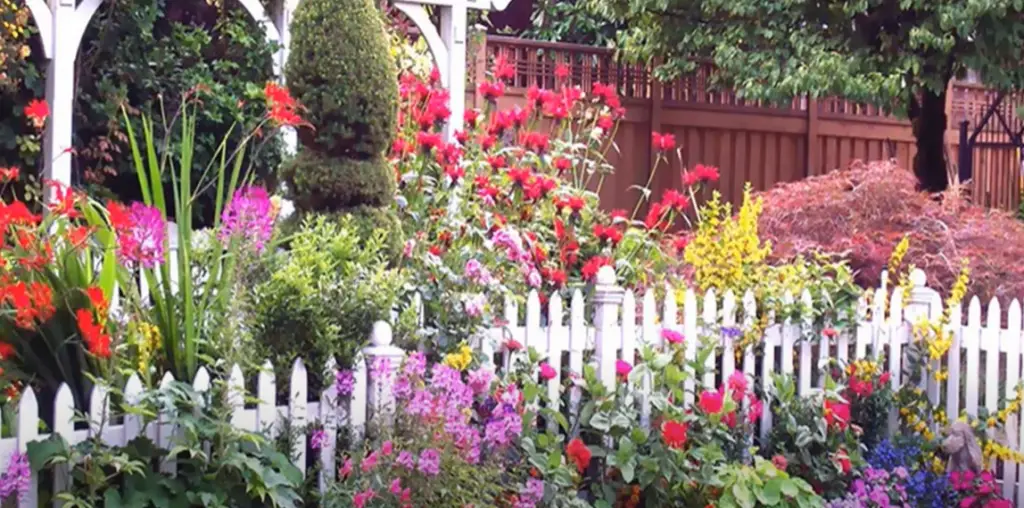
Create four distinct seasons
An English garden isn’t just about planting flowers in spring and summer; it should be designed with all four seasons in mind. Consider planting evergreens that will stay green throughout winter, such as box hedges or conifers, as well as deciduous trees and shrubs that provide bright autumnal colors. This will ensure your outdoor space looks beautiful all year round [2]!
What do you need to create an English garden?
Creating a traditional English garden can bring an old-world charm to your outdoor space. Whether you have a small courtyard or a large acreage, it’s possible to mimic the lushness and exuberance of an English countryside garden by using certain elements. To create an English garden, you will need:
- Structural elements like hedges, arches, or trellises
- Pathways made of gravel or crushed stone
- Trees such as oaks and sycamores for providing shade and shelter
- Flower beds with cottage flowers like roses, lavender, hollyhocks, and delphiniums
- Vibrant colors to add interest to your design
- Statues, birdbaths, and other ornamental decorations for a pop of personality
- A pond or water feature for bringing life to the garden.
Creating an English garden requires patience and hard work, but it can be extremely rewarding when done correctly. With the right planning and design elements, you can create a tranquil outdoor space that will make you feel like you’ve stepped into another world.
To create an English garden, follow these simple steps:
- Sketch out a plan for your garden and buy the necessary supplies.
- Dig out pathways and install structures like arches or trellises.
- Plant trees for shade, as well as shrubs and bushes to provide structure.
- Add flower beds with cottage flowers in vibrant colors.
- Place statues, birdbaths, and other decorations around the garden to give it personality.
- Finish off the look by adding a pond or water feature for additional life and movement.
With these steps, you’ll be able to create a beautiful English garden that is perfect for welcoming friends and family into your outdoor space [3]!
How do you maintain an English garden?
Maintaining an English garden requires regular upkeep, as well as knowledge of plant care and gardening techniques. Here are some tips to help maintain your English garden:
- Prune Plants Regularly: Pruning is essential for maintaining the shape and size of plants in your English garden. Remove dead leaves, flowers, stems, and other debris from perennial and annual plants regularly to encourage healthy growth.
- Mulch Plant Beds: Adding mulch helps lock in moisture for plants in your English garden while also controlling weeds that compete with them for nutrients. Consider using organic mulches such as bark chips or compost to provide extra nutrition for the soil beneath your plants.
- Water Regularly: Make sure to water your English garden regularly, taking care not to overwater. Consider collecting rainwater in barrels or other containers in order to reduce your water usage and prevent runoff from entering local waterways.
- Use Natural Fertilizers: To help ensure healthy growth for your plants, use natural fertilizers that are rich in nitrogen and phosphorus, such as composted manure or fish emulsion.
- Control Pests Organically: In order to keep pests from damaging the plants in your English garden, try using organic methods such as companion planting with pest-repellent herbs (e.g., lavender), introducing beneficial bugs into the garden, and handpicking any visible pests from the plants themselves.
- Remove Weeds: Keep a close eye out for any weeds that may be sprouting up in your English garden, as they can quickly take over and deprive the desired plants of vital nutrients and water. If spotted, remove the weeds manually or use an organic herbicide to eliminate them without harming other life in the garden.
- Inspect Regularly: Make sure to inspect your English garden regularly for signs of disease or pest infestation. If you notice any potential problems, address them quickly with the appropriate treatment methods before they become more serious. Following these tips will help ensure that your English garden is maintained properly and stays beautiful for years to come!
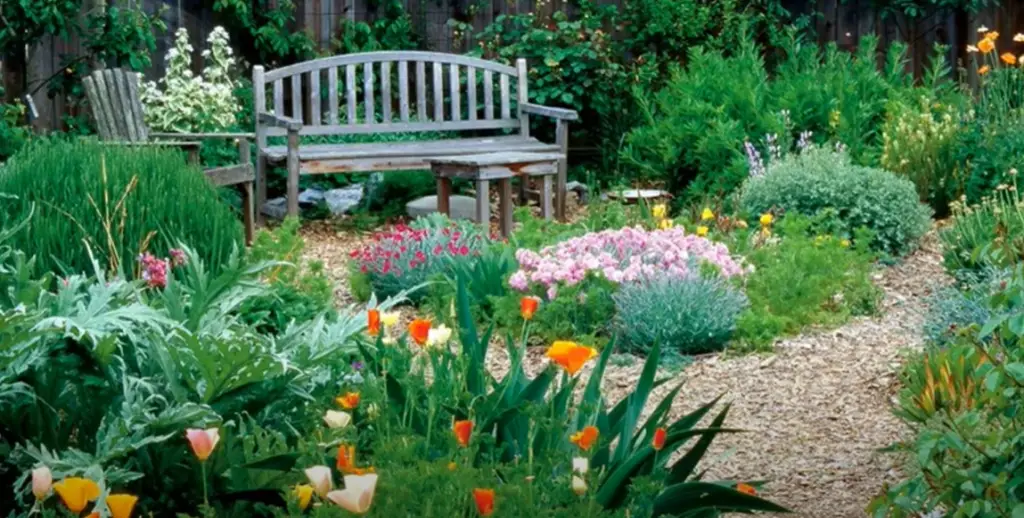
FAQ
What makes it an English garden?
An English garden is a type of traditional garden that originated in England. It typically contains lawns, paths, and ornamentation such as statues, sculptures, and other hardscape elements. The gardens may also include flower beds and shrubs with winding paths usually lined with hedges or low walls. Plants are often selected for their color, texture, fragrance, and aesthetics to create an environment of tranquility. English gardens have been designed since the 17th century and continue to be popular today.
What types of plants are used in an English garden?
English gardens utilize many types of plants including trees, shrubs, perennials, annuals, evergreens, grasses, herbs, and bulbs. Some examples include roses, lavender, hydrangeas, rhododendrons, astilbe, and many other flowering plants. Herbs such as chives and thyme are often used to provide texture in the garden. Trees such as oaks, beeches, and maples can provide a strong vertical element while providing shade. Evergreens like boxwood and yews are often used for hedges or low walls to define pathways and separate areas of the garden. Grasses may also be included to add texture and create a more naturalistic look.
What is the typical style of an English garden?
The typical style of an English Garden tends to be informal yet structured. The paths are usually curved rather than straight giving it a softer, more relaxed feel. The planting beds tend to be asymmetrical and overflowing with plants to create a lush, abundant look. The garden is often filled with hidden pathways, sculptures, benches, and other decorative features to provide interest and a sense of mystery. Many English gardens also incorporate ponds or water features as focal points. Overall the design should evoke feelings of tranquility and peacefulness.
What are some tips for creating an English garden?
Creating an authentic English-style garden requires careful planning. Begin by sketching out the layout on paper or using a computer program like Autodesk HomeStyler or SketchUp so you can visualize the final effect before beginning work on your garden. When selecting plants, choose varieties that will thrive in your climate. Also consider the height, texture, and color of the plants to create a balanced design. Finally, add hardscape elements such as sculptures, benches, pathways, and walls to give structure and interest to the garden. With proper planning and care you can create an English-style garden that is both beautiful and tranquil.
What are some common mistakes when creating an English garden?
One of the most common mistakes when creating an English Garden is not allowing enough space between plants for them to grow properly. The different varieties of plants need room to spread out for them to reach their full potential. Additionally, there should be at least 18 inches of soil beneath any hardscape elements like pathways or walls to allow for proper root growth. Finally, avoid over-watering plants as too much water can cause the roots to rot and prevent them from thriving in the garden.
Are there any restrictions when designing an English Garden?
When designing an English Garden, it is important to consider any local or regional regulations on watering or fertilizing that may be in place. Additionally, some areas have restrictions on the type of hardscape materials that can be used so it’s important to check with your local authorities before beginning work. It’s also important to consider any by-laws related to height and scale if building walls or other features as they must remain within your property lines. Finally, be sure to properly maintain any water features in the garden to reduce the risk of contamination or pollution.
How do you structure an English garden?
When structuring an English garden, the key is to create a balance between hardscape and softscape elements. Pathways, walls, sculptures, and other hardscape elements should be used to define spaces within the garden while also providing structure and interest. Planting beds should be designed in asymmetrical shapes with a variety of plants chosen for their color, texture, and height. Additionally, incorporate ponds or water features as focal points for added interest.
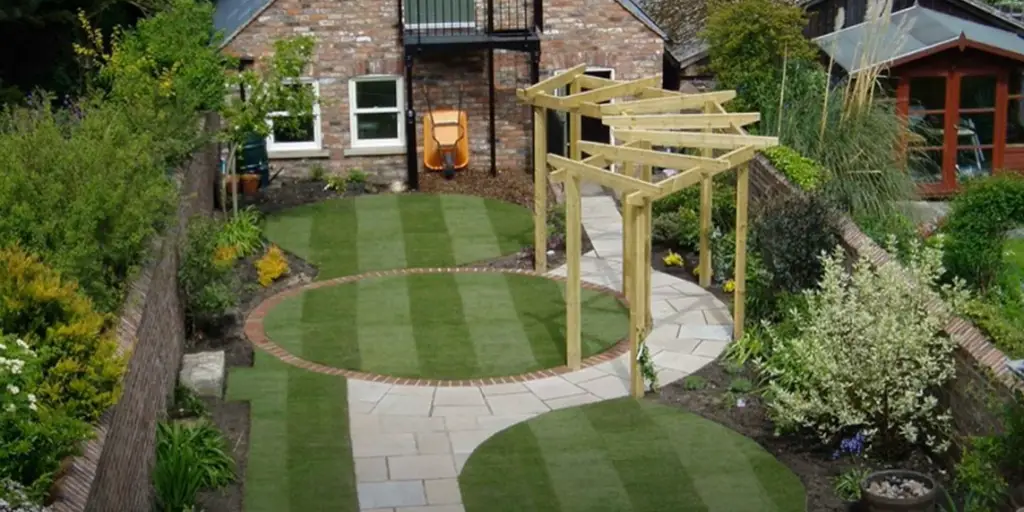
What is a typical British garden?
A typical British garden is often characterized by a mix of traditional and modern elements. Hedges, topiaries, and other formal elements may be used to provide structure while wildflower meadows, fruit tree orchards, and vegetable patches are popular additions as well. Grasses may also be included to add texture and create a more naturalistic look. Ponds or water features can be used as focal points while pathways and stepping stones provide interest throughout the garden. The overall design should evoke feelings of comfort and relaxation.
What is the most popular garden in England?
The most popular garden style in England is the traditional cottage-style garden. This type of garden typically features informal planting beds, with a mix of flowers and herbs planted in asymmetrical arrangements. Hedges are often used to define spaces within the garden and statuary or sculptures may be added for interest. Pathways and stepping stones are also common elements that allow easy circulation throughout the space. Additionally, ponds or water features can be included as focal points to create a tranquil atmosphere.
What is the most popular garden in the UK?
The most popular garden style in the UK is the modern contemporary garden. This type of garden typically features sleek, minimalist design elements such as hardscaping materials like slate or granite with an emphasis on straight lines. Planting beds are often designed with structured patterns and low-maintenance plants that require minimal upkeep. Water features may also be included as focal points for added interest, and modern lighting can be used to create a dramatic atmosphere at night.
What is the difference between a French garden and an English garden?
The main difference between a French garden and an English garden is the overall design aesthetic. French gardens typically feature more formal elements such as symmetrical plant beds, topiary shapes, and large fountains or sculptures to create a classic, elegant look. In contrast, English gardens are usually less structured with informal planting beds featuring wildflowers and other cottage-style blooms. Water features may be included but often take a more natural form such as ponds or streams. Hedges are also used to define spaces within the garden and pathways provide easy circulation throughout the space.
What are English-garden style elements?
English-garden style elements typically include informal planting beds featuring a mix of wildflowers, herbs, and other cottage-style blooms. Hedges can be used to define spaces within the garden and pathways provide easy circulation throughout the space. Statuary or sculptures may also be added for interest and focal points such as ponds or water features can be included to create a tranquil atmosphere. Additionally, paving stones or stepping stones may be used to add texture and further define the layout of the garden.
How to decorate an English garden?
When decorating an English garden, it is important to consider the overall design aesthetic and choose elements that create a calming and inviting atmosphere. The planting beds should be designed in asymmetrical shapes with a variety of plants chosen for their color, texture, and height. Additionally, incorporate ponds or water features as focal points for added interest. Statuary or sculptures may also be used throughout the garden to add visual interest while pathways provide easy circulation throughout the space. Finally, modern lighting can be used to highlight the various elements of your garden when the sun sets.
Useful Video: How to Make a Garden | English Garden Design Ideas
Conclusion
English Garden is a wonderful place to visit any time of the year. With its variety of activities and attractions, it is a great destination for friends and family alike. The enchanting atmosphere makes it an ideal spot for relaxing, picnics, and exploring nature. Whether you’re looking for a day trip or a weekend getaway, English Garden has something for everyone. From historical monuments to lush gardens, there are so many things to do in this special place. There’s no better way to experience all that England has to offer than by visiting the beautiful English Garden!
References:
- https://www.thespruce.com/what-is-an-english-garden-5193192
- https://www.homesandgardens.com/ideas/english-garden-ideas
- https://www.happysprout.com/outdoor-living/english-garden-ideas/





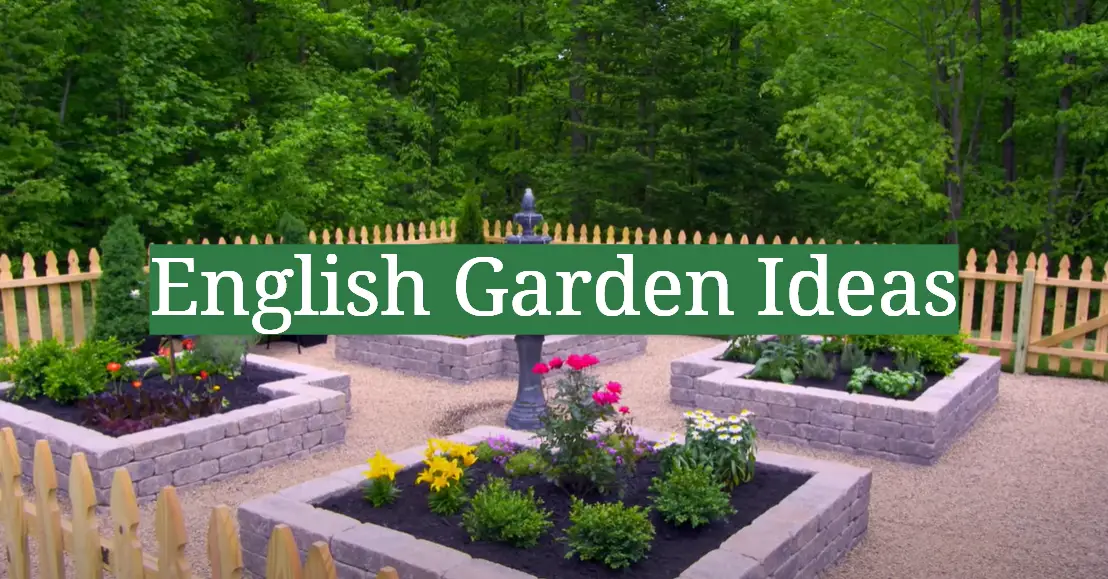




Leave a Reply
View Comments